The Eiffel Tower. Instantly recognisable, universally admired, it’s more than just iron latticework; it’s a global emblem of Parisian chic, architectural audacity, and a pivotal moment in industrial history. Since 1889, Gustave Eiffel’s masterpiece has dominated the Paris skyline, a testament to engineering prowess and visionary design. But have you ever paused to wonder about an Eiffel Tower reimagined – what if this iconic structure had been conceived by a different architectural mind, perhaps reflecting alternative architectural styles from other famous architects? What if Zaha Hadid’s fluid dynamism, Antoni Gaudí’s organic spiritualism, or Le Corbusier’s modernist rigour had shaped its form?
Thanks to the fascinating intersection of AI architecture and artistic creativity, we no longer have to merely imagine such transformations. Lucas Kenji has embarked on a captivating visual exploration, employing AI art principles to generate a series of images that present the Eiffel Tower reimagined in truly astonishing ways. This article delves into these remarkable reinterpretations, each a unique take on Paris icon design, celebrating the original genius of Eiffel while exploring the boundless possibilities that arise when visionary concepts meet cutting-edge technology. Join us at The Urban Herald for a journey through a Paris of dreams, where familiar landmarks take on extraordinary new identities.
The Iron Lady: A brief history of Gustave Eiffel’s masterpiece
To fully appreciate the creativity of these reinterpretations, one must first understand the groundbreaking nature of the original. Erected for the Exposition Universelle of 1889 – a World’s Fair celebrating the centennial of the French Revolution – the Eiffel Tower was a bold declaration of France’s industrial and engineering capabilities. Designed by Gustave Eiffel, Maurice Koechlin, and Émile Nouguier, with Stephen Sauvestre as architect, its 300-metre (at the time) wrought-iron structure was the tallest man-made edifice in the world, a title it held for 41 years.
Comprising over 18,000 individual iron parts and 2.5 million rivets, its construction was a marvel of precision and speed. Yet, it wasn’t without its detractors; a coterie of prominent artists and writers initially decried it as a monstrous “black smokestack.” Time, however, has been its greatest ally. The Tower defied its critics, evolving from a temporary exhibition piece into an enduring symbol of Paris, a beacon of innovation, and one of the most visited paid monuments globally. Its design was not just about height, but about transparency, wind resistance, and an aesthetic that was undeniably modern.
AI Steps In: Reimagining Architectural Icons
Fast forward to the 21st century, and a new kind of revolutionary tool is impacting the creative landscape: Artificial Intelligence. AI’s burgeoning role in art and design allows for speculative explorations that were once confined to sketches or complex renderings. Platforms and algorithms can now analyse vast datasets of architectural styles, forms, and philosophies, then synthesise this knowledge to generate novel visual concepts.
This series of AI art is a prime example of this creative symbiosis. By prompting AI with the styles of various master architects, the artist has conjured visions that are more than mere pastiche; they are thoughtful interpretations that spark dialogue about authorship, influence, and the very essence of architectural identity. This use of AI isn’t about replacing human creativity but augmenting it, offering a digital sandbox where “what if” scenarios can be vividly brought to life, allowing us to see the familiar through an entirely new lens.
The Eiffel Tower reimagined: A gallery of architectural visions
Prepare to journey through a gallery of reimagined Eiffel Towers. Each vision offers a unique perspective on what this Parisian icon could have been. We’ll explore the signature styles of various architects and how they translate into these fascinating structural concepts.
Antoni Gaudí’s organic fantasia
Antoni Gaudí, the master of Catalan Modernism, is celebrated for his deeply spiritual, nature-inspired designs, where structure and ornament intertwine into fantastical, almost living forms. Think of the Sagrada Família or Park Güell.
An Eiffel Tower by Gaudí, as envisioned by AI, might eschew metallic rigidity for flowing, parabolic curves and textured surfaces, perhaps adorned with colourful mosaics (trencadís). The structure could evoke a colossal, skeletal tree or a mystical, organic spire, its openings appearing like natural grottoes, connecting the earth with the Parisian sky in a deeply symbolic way.
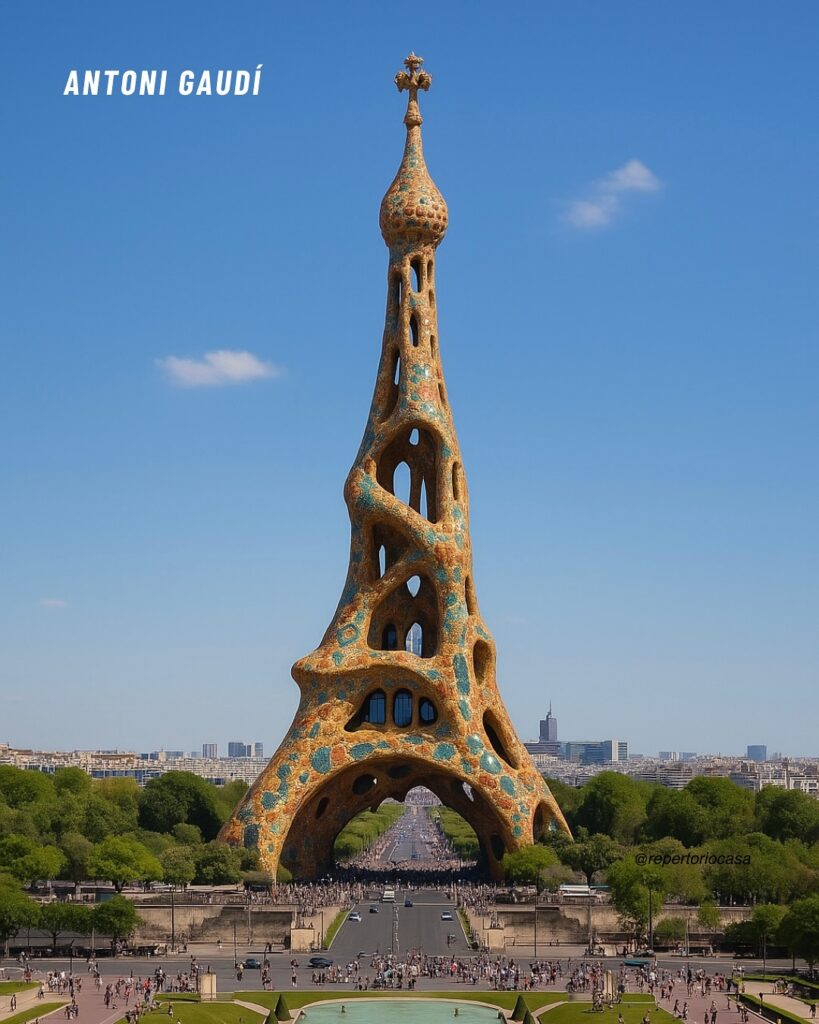
Zaha Hadid’s parametric dynamism
Dame Zaha Hadid was a revolutionary force in architecture, known for her radically futuristic, deconstructivist, and parametric designs. Her buildings are characterised by sweeping fluid lines, fragmented geometries, and a sense of dynamic movement.
A Zaha Hadid Eiffel Tower, as interpreted by AI, would likely be a breathtaking spectacle of fluid metallic forms, appearing as if sculpted by motion or data flows. Sharp angles might converge with dramatic curves, creating a structure that seems to defy gravity and convention, a beacon of 21st-century neo-futurism on the Champ de Mars.
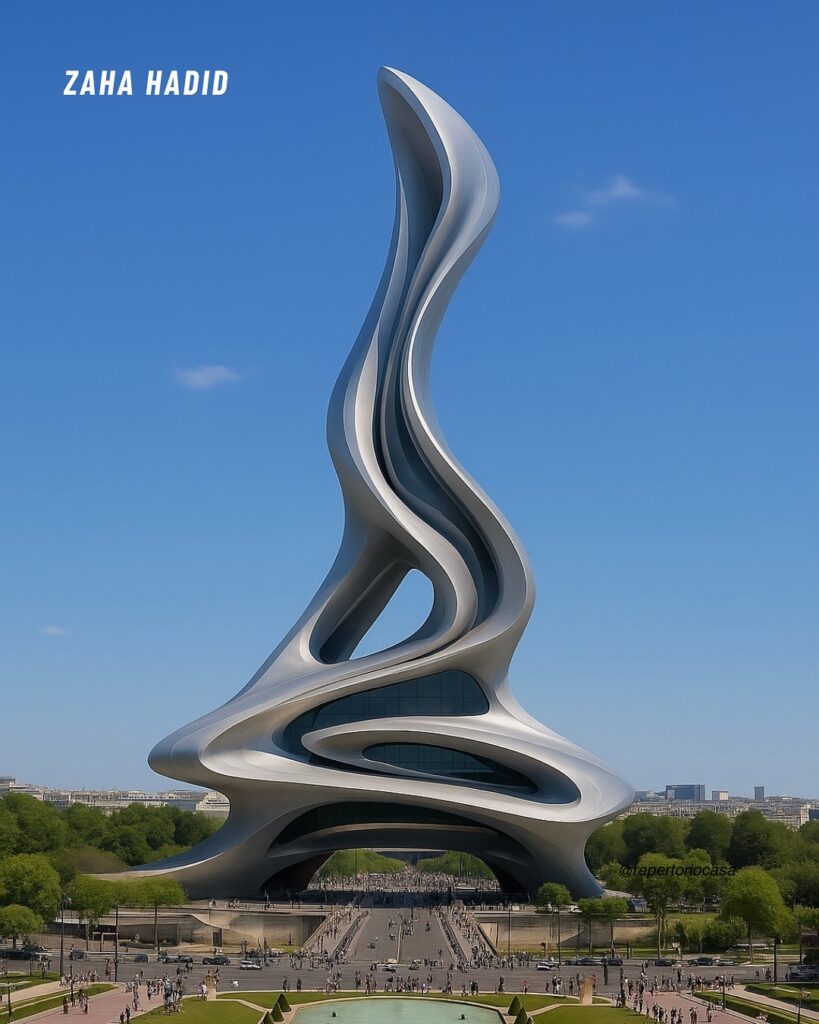
Santiago Calatrava’s sculptural engineering
Santiago Calatrava is renowned for his “architecture of movement,” blending engineering prowess with breathtaking sculptural forms often inspired by organic structures like skeletons or wings. His works, such as the Milwaukee Art Museum or the City of Arts and Sciences in Valencia, are dramatic and instantly recognisable.
Envision Calatrava’s Eiffel Tower: it might present as a soaring, white, skeletal structure, its metallic bones elegantly curved and arranged to evoke a sense of lightness and aspiration. Perhaps elements would appear to unfurl or twist, capturing a dynamic moment in an otherwise static form, a true marriage of art and structural expression.
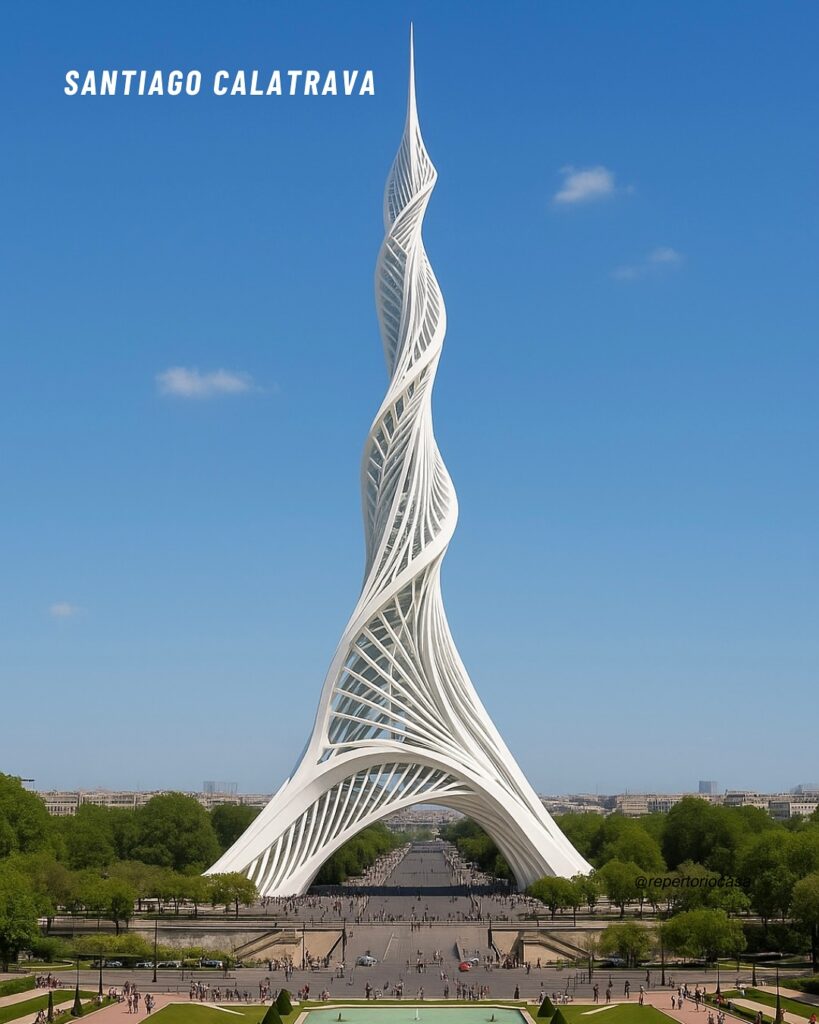
Norman Foster’s high-tech precision
Lord Norman Foster is a central figure in British high-tech architecture, emphasising technological innovation, sustainability, and sleek, refined modernism. His buildings, like The Gherkin in London or the Millau Viaduct, often showcase expressed structure and sophisticated engineering.
A Foster-designed Eiffel Tower could be a marvel of polished steel and glass, perhaps with a more streamlined, aerodynamic profile. It might incorporate visible structural systems and cutting-edge sustainable technologies, embodying a cool, rational elegance and a forward-looking vision of Parisian technological prowess.
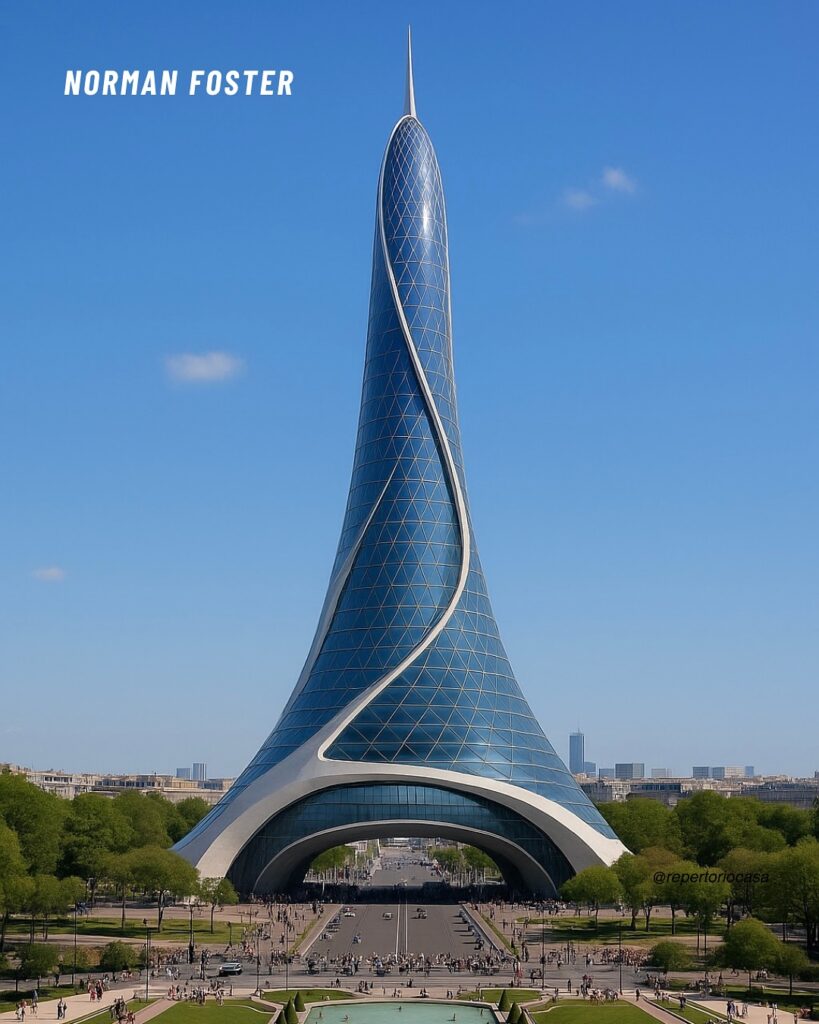
Lina Bo Bardi’s bold modernism
Lina Bo Bardi was a fiercely original modernist architect known for her socially conscious designs that often incorporated raw materials, bold forms, and a deep understanding of local culture, particularly in Brazil (e.g., MASP, SESC Pompéia).
An Eiffel Tower through Bo Bardi’s lens, as imagined by AI, might feature robust, perhaps even Brutalist-inspired concrete elements alongside the iron, with strong, clear lines and an emphasis on public space and interaction. It could feel more grounded, yet powerfully assertive, perhaps with pops of bold colour on its structural components.
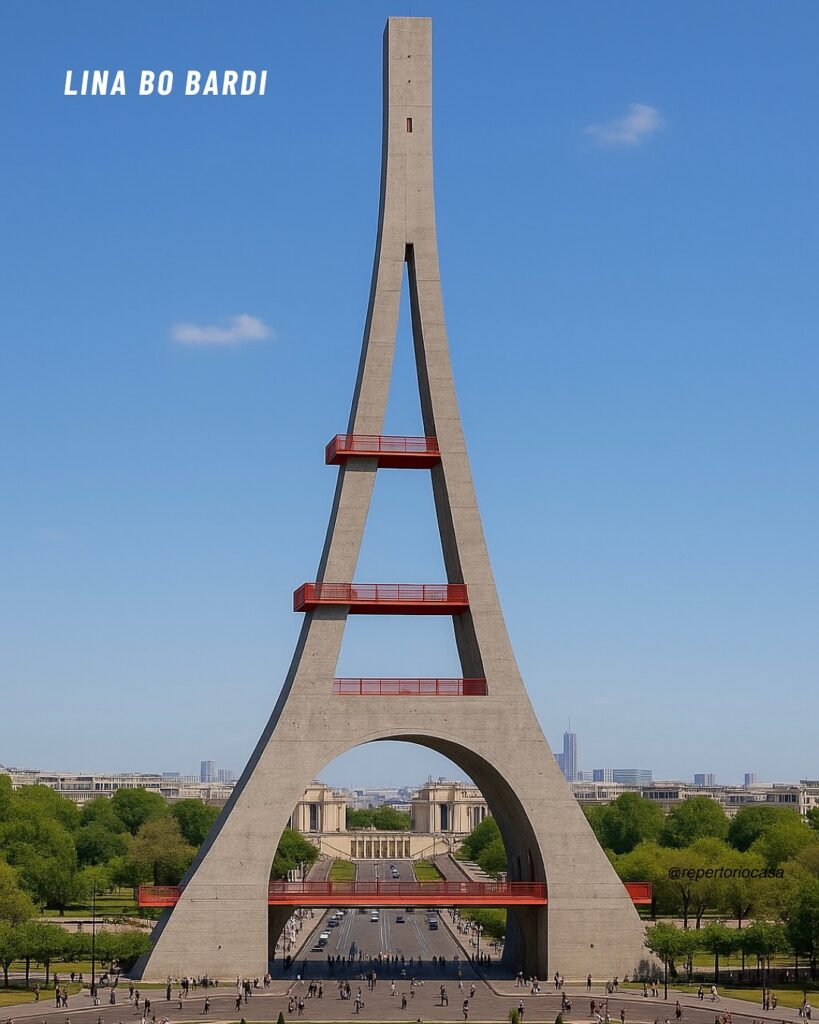
Bjarke Ingels’ playful pragmatism
Bjarke Ingels, founder of BIG (Bjarke Ingels Group), is known for his “hedonistic sustainability” and playful, innovative solutions that often merge programmatic functions in unexpected ways – think a power plant topped with a ski slope.
A BIG Eiffel Tower might transform the icon into a multi-functional vertical park or an interactive sustainable landmark. The AI interpretation could show a spiralling green pathway integrated into the structure, or modular elements creating a dynamic, almost pixelated silhouette, making the Tower not just an observation deck but an experience.
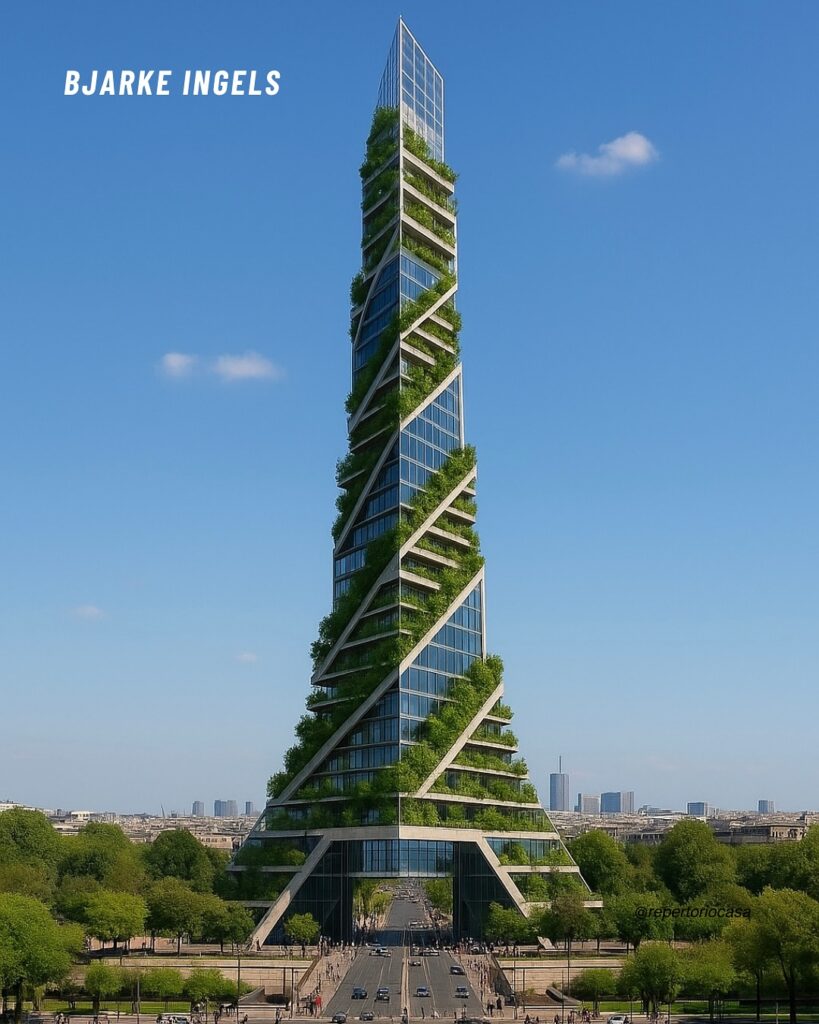
Frank Gehry’s deconstructivist sculpture
Frank Gehry is world-renowned for his deconstructivist style, creating buildings that appear as dynamic, fragmented sculptures, often clad in reflective metals (e.g., Guggenheim Museum Bilbao, Walt Disney Concert Hall).
A Gehry-fied Eiffel Tower, as envisioned by AI, would be an explosion of metallic shards and tilting, asymmetrical forms. It would challenge the original’s symmetry with a controlled chaos, its surfaces reflecting the Parisian light in a dazzling, ever-changing display – less a tower, more a colossal abstract sculpture.
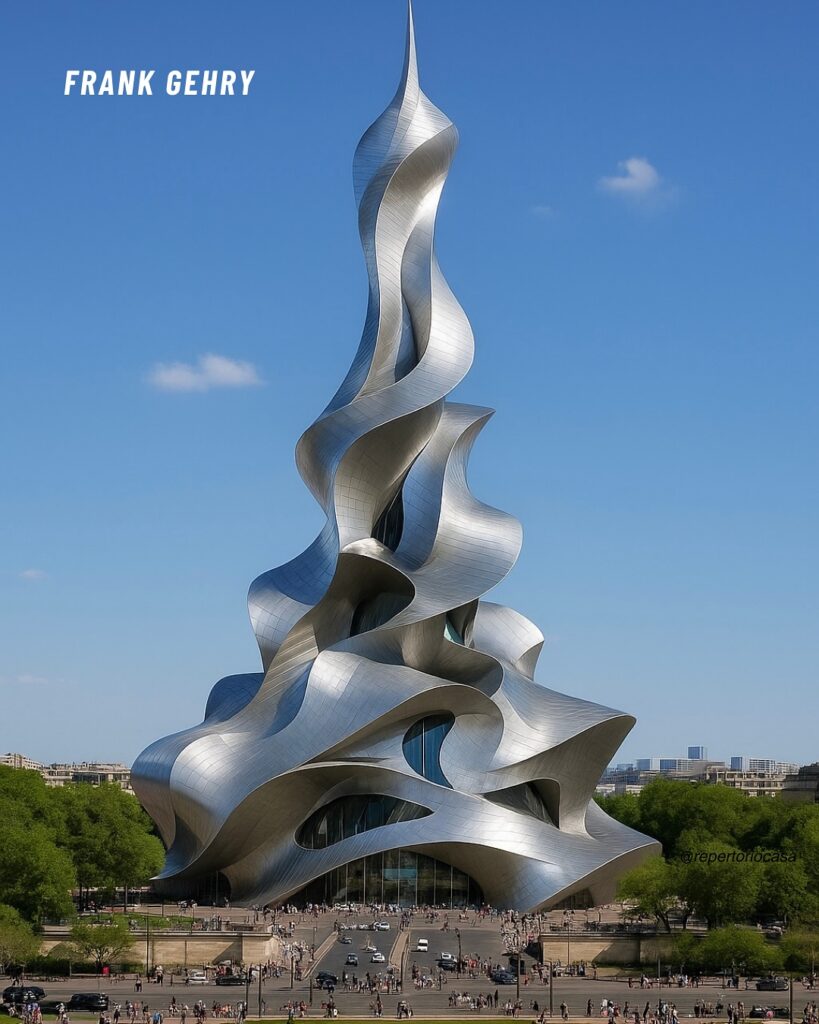
Le Corbusier’s modernist manifesto
Le Corbusier was one of the pioneers of modern architecture, advocating for functionalism, standardised forms, and his “Five Points of Architecture.” His influence with materials like Béton brut (raw concrete) is legendary.
An Eiffel Tower by Le Corbusier might be a stark, rational structure, perhaps embodying his principles of pilotis and free façade, even at such a scale. The AI interpretation could showcase clean geometric lines, an emphasis on structural honesty, and a functional aesthetic, transforming the iron icon into a purist statement.
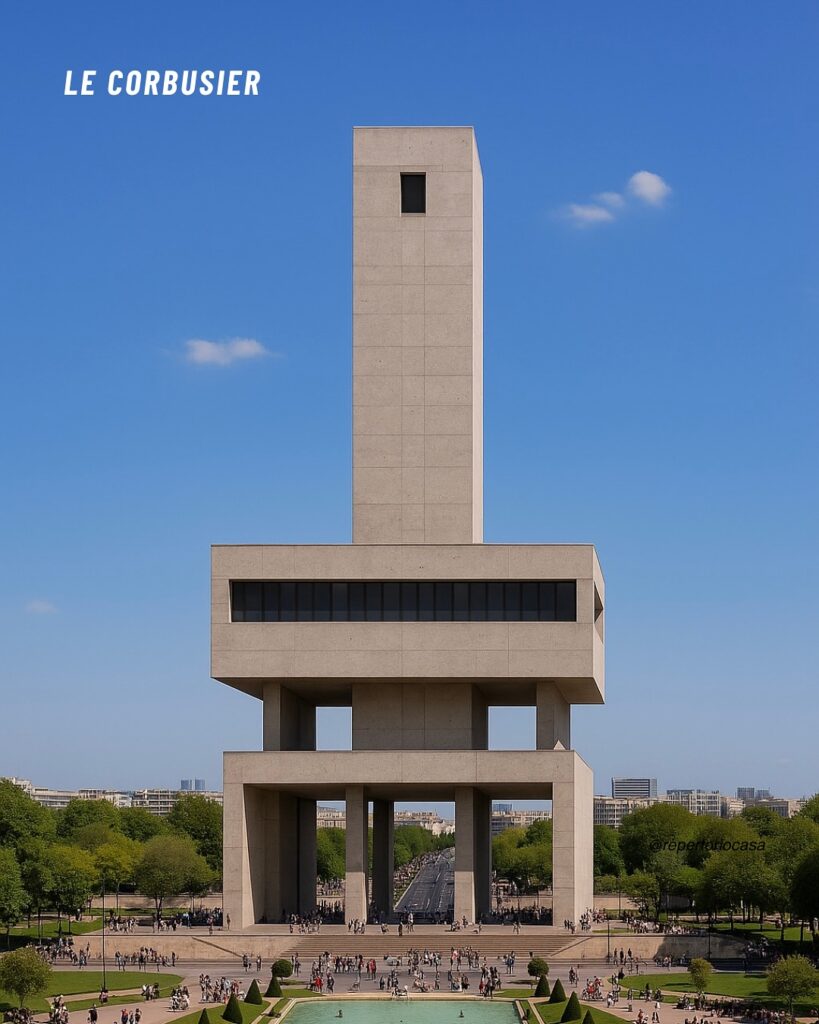
Louis Sullivan’s skyscraper poetry
Known as the “father of skyscrapers” and a mentor to Frank Lloyd Wright, Louis Sullivan believed “form ever follows function,” yet his designs were rich with intricate, organic ornamentation, often in terracotta or metal, gracing the steel frames of early tall buildings.
A Sullivan-esque Eiffel Tower, imagined by AI, might retain its soaring verticality but feature bands of Sullivan’s signature Celtic or nature-inspired decorative motifs. The ironwork itself could take on these detailed patterns, blending structural expression with a uniquely American ornamental richness.
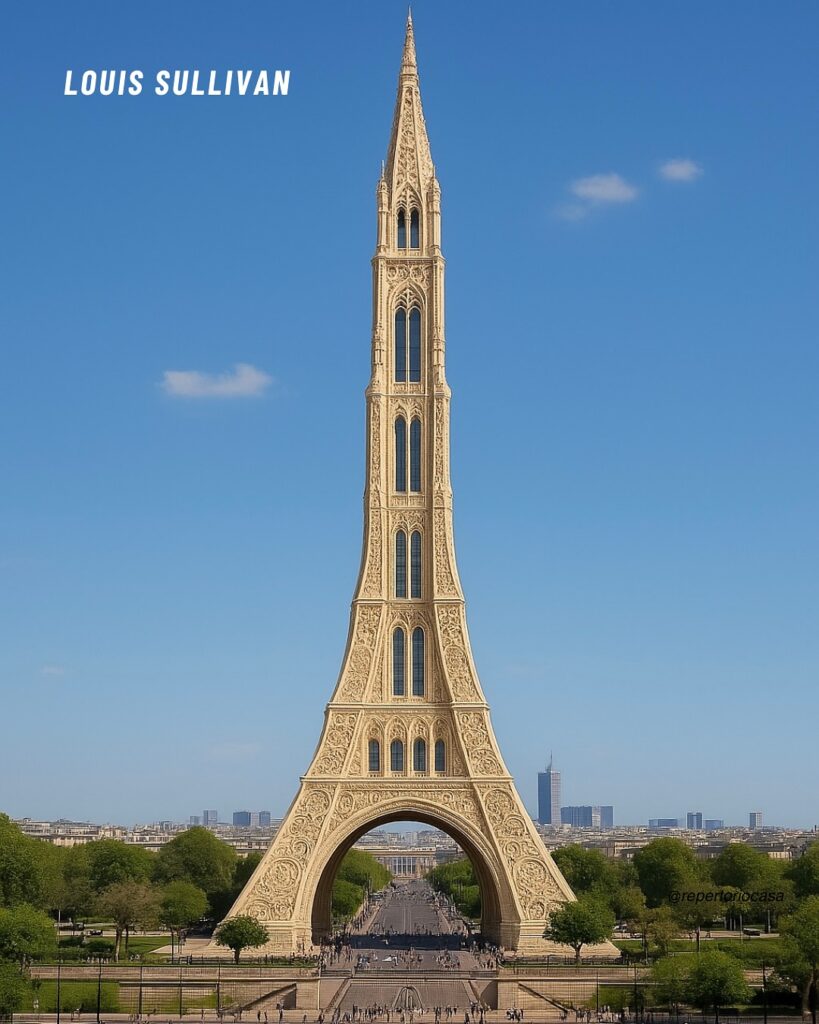
Frank Lloyd Wright’s organic landmark
Frank Lloyd Wright, a titan of American architecture, championed “organic architecture”—the harmonious integration of building, site, and human life. Known for his Prairie School designs with their strong horizontal lines, innovative use of natural materials, and open interior spaces, Wright sought to create an architecture for democracy that was uniquely American.
An Eiffel Tower envisioned through Wright’s philosophy, as interpreted by the image below, might present a fascinating dialogue between vertical aspiration and his signature horizontality. Perhaps it would feature cantilevered observation platforms extending like prairie horizons, or a robust central core clad in textured concrete or stone, with intricate geometric patterns replacing the delicate iron latticework. It could appear to grow organically from the Champ de Mars, a truly American architectural statement on Parisian soil, blending nature, structure, and human experience.

Ruy Ohtake’s sculptural vibrancy
Ruy Ohtake was celebrated for his bold use of colour and striking sculptural forms in concrete, bringing a vibrant modernism to Brazilian architecture. This AI vision might also evoke the playful dynamism of Alexander Calder’s iconic mobiles and stabiles, with their balanced, abstract components.
Imagine an Eiffel Tower infused with Ohtake’s vibrant colour palette and concrete curves, or perhaps deconstructed into large, balanced, abstract elements reminiscent of a monumental Calder stabile, capturing a sense of kinetic energy and artistic bravura.
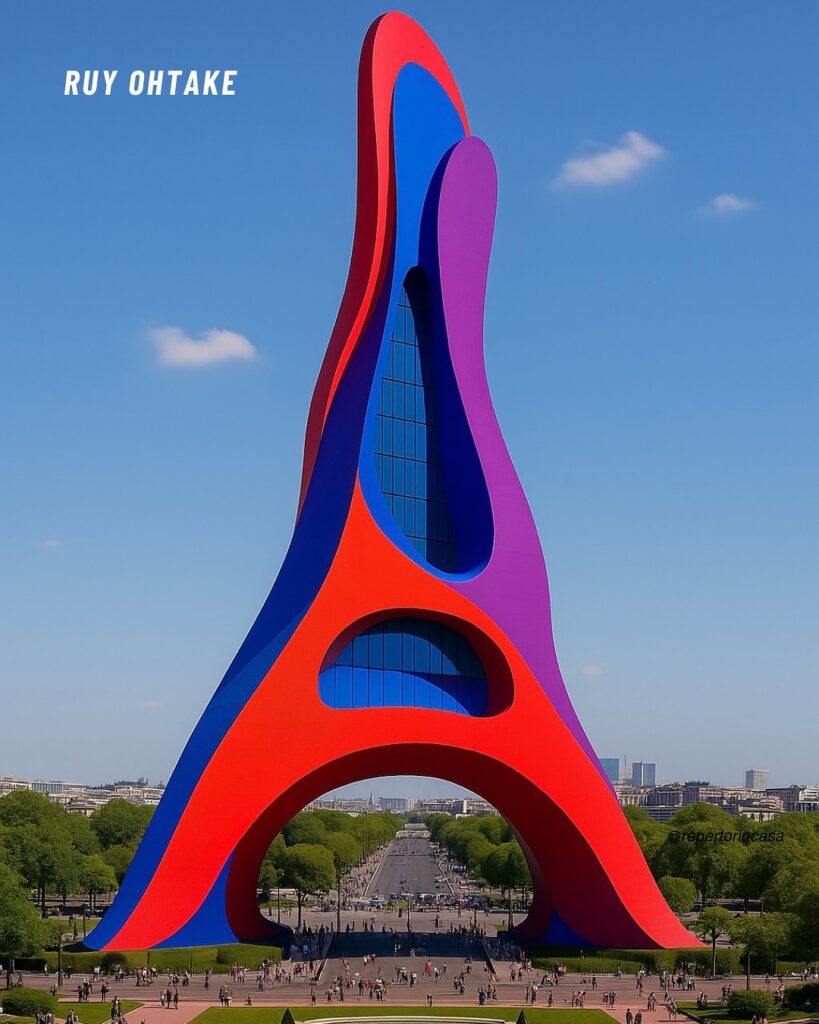
Tadao Ando’s concrete haiku
Tadao Ando is revered for his mastery of reinforced concrete, creating serene, minimalist spaces where light and shadow play across impeccably smooth surfaces. His architecture often fosters quiet contemplation and a deep connection with nature.
An Ando Eiffel Tower, as interpreted by AI, would likely be a monolithic structure of breathtaking simplicity, rendered in flawless concrete. Geometric purity, subtle openings allowing dramatic interplay of light, and perhaps an integration of water or greenery could redefine the icon as a serene, minimalist beacon.
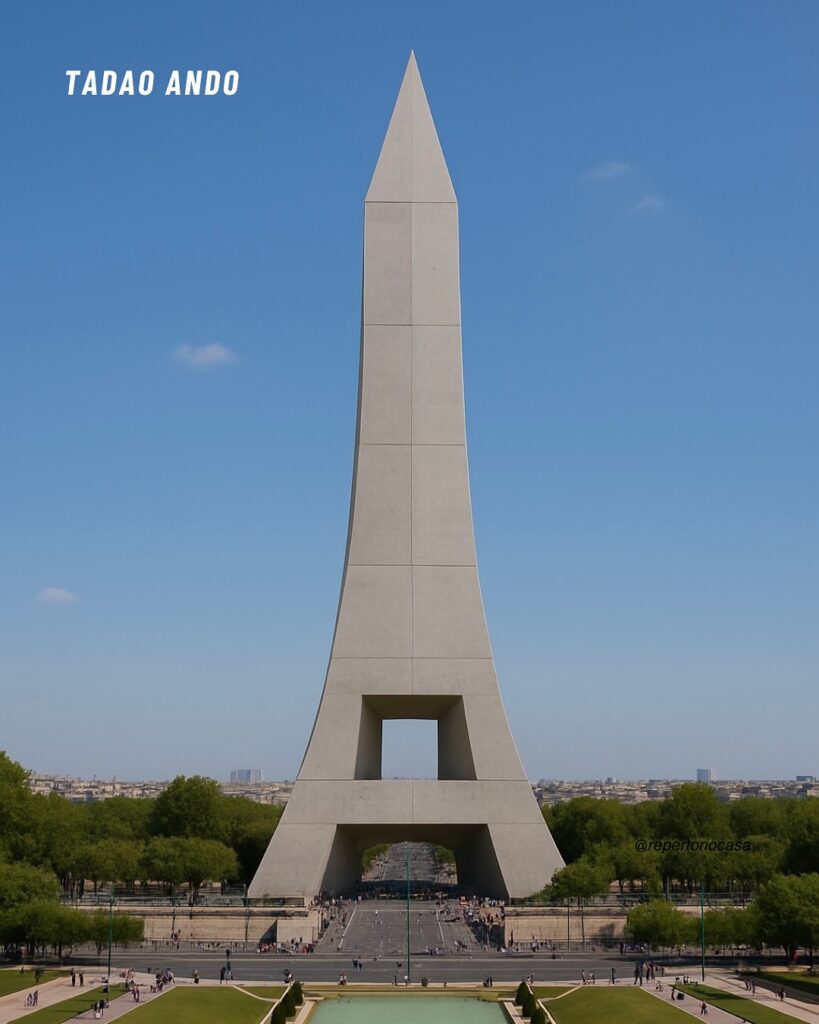
Mies van der Rohe’s rational elegance
Ludwig Mies van der Rohe, a giant of the International Style, championed the principle of “less is more.” His architecture is characterised by clarity of structure, meticulous detailing, and the use of modern materials like steel and glass to create spaces of refined, rational beauty.
A Miesian Eiffel Tower could be an exercise in structural purity, its steel framework expressed with utmost clarity and precision. The AI vision might showcase an almost severe elegance, where every line and connection serves a purpose, potentially incorporating glass elements to create a sense of lightness and transparency within its defined geometric form.
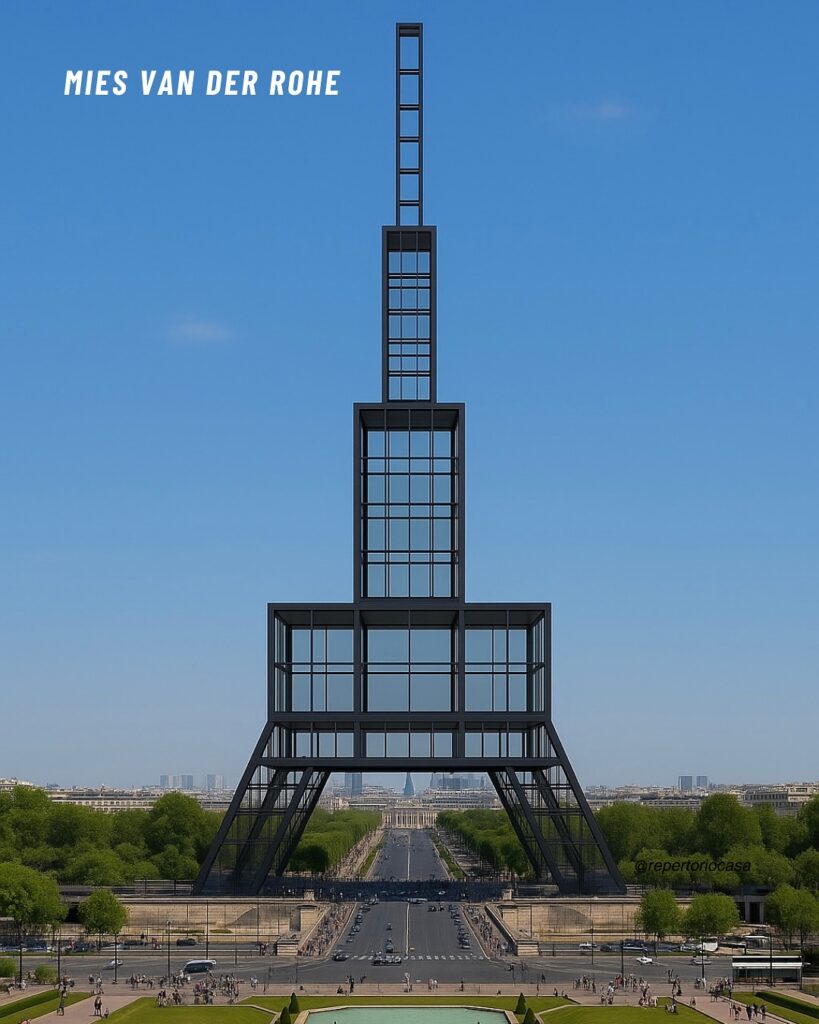
Kengo Kuma’s dialogue with nature
Kengo Kuma is known for his sensitive use of natural materials, particularly wood, and his desire to create architecture that harmonises with its surroundings, often reinterpreting traditional Japanese techniques. His work emphasises lightness, texture, and sustainability.
An Eiffel Tower envisioned by Kuma might be a breathtaking structure of intricate timber latticework, filtering light and shadow like a forest canopy. The AI interpretation could show the iconic form rendered in warm, organic materials, creating a landmark that feels both monumental and intimately connected to nature, a softer, breathing icon.
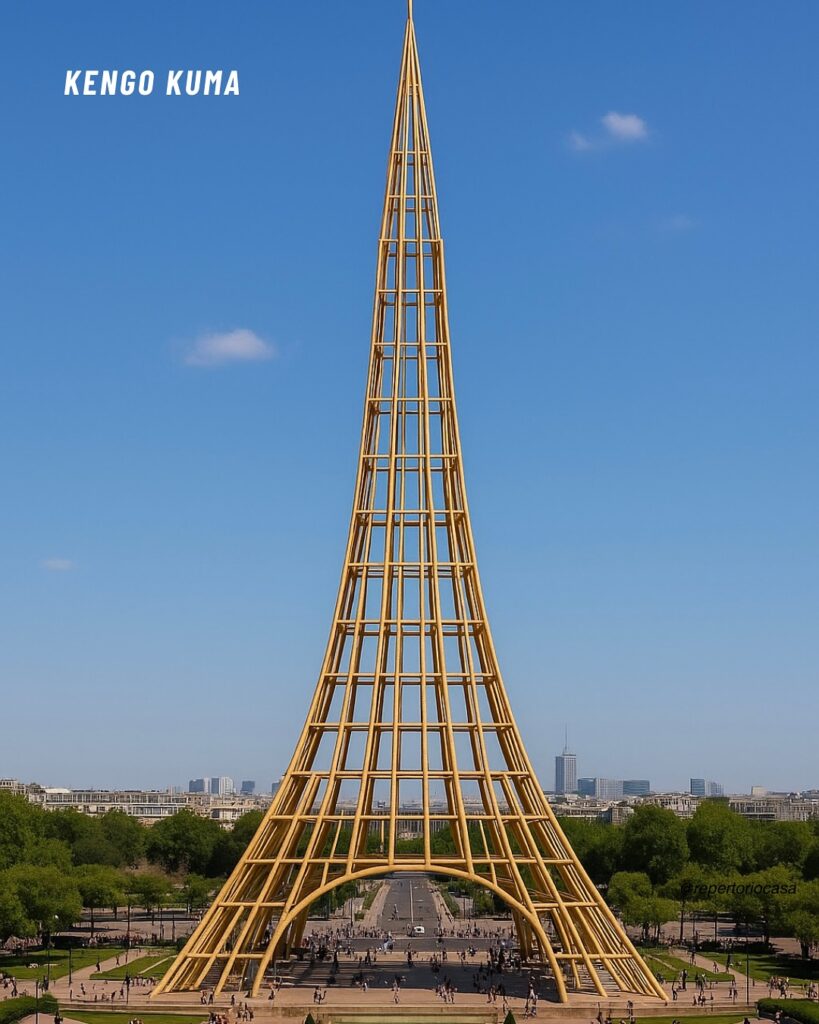
Jean Nouvel’s contextual illusions
Jean Nouvel is celebrated for his contextual approach, creating unique buildings that respond to their specific site and culture, often using innovative facades, light, and transparency to create captivating visual effects (e.g., Institut du Monde Arabe, Torre Agbar).
A Nouvel-designed Eiffel Tower could be a high-tech marvel, its surfaces perhaps clad in responsive materials that shimmer, reflect, or even partially dematerialise against the Parisian sky. The AI might depict a tower that plays with perception, its form defined as much by light and reflection as by its physical structure, a truly 21st-century Parisian spectacle.

Oscar Niemeyer’s sensual curves
Oscar Niemeyer was a pivotal figure in modern architecture, renowned for his free-flowing, sensual curves, and his innovative use of reinforced concrete to create lyrical, sculptural buildings that feel both monumental and graceful (e.g., Brasília’s civic buildings, Niterói Contemporary Art Museum).
An Eiffel Tower through Niemeyer’s eyes, as imagined by AI, would likely trade iron latticework for sweeping, poetic curves of white concrete. It might rise as a fluid, abstract sculpture, its forms echoing the beauty of natural contours, a monument to sensuality and bold Brazilian modernism in the heart of Paris.
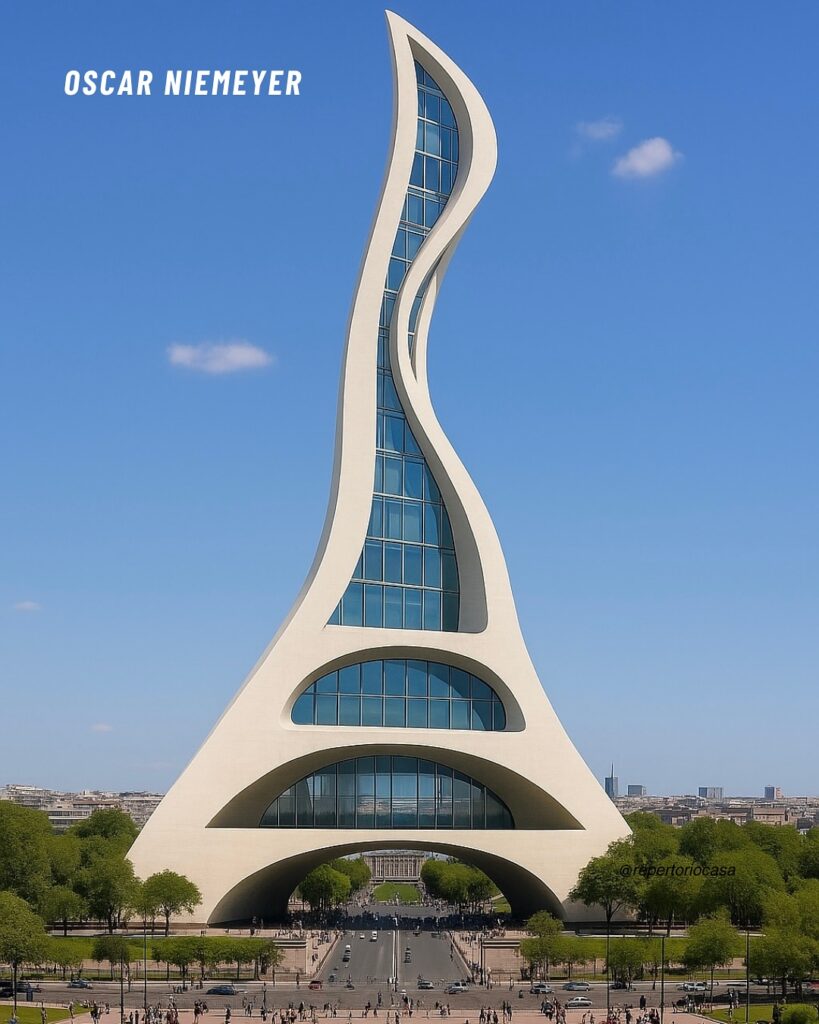
The creative alchemy: AI and the architectural imagination
This gallery of reimagined Eiffel Towers does more than just entertain. It highlights the evolving relationship between technology and human creativity. Artificial intelligence, in this context, serves as a powerful collaborator, capable of synthesising vast amounts of stylistic information and generating novel outputs at a remarkable speed.
It’s important to note that these tools are not replacing architects or designers. Rather, they are augmenting the creative process, offering new avenues for ideation, experimentation, and visual communication. For architectural students, professionals, and enthusiasts alike, AI-driven design explorations can:
- Spark Inspiration: Break creative blocks and suggest unconventional solutions.
- Enhance Visualisation: Quickly prototype and visualise complex or alternative design concepts.
- Facilitate Learning: Provide a dynamic way to understand and compare different architectural styles and philosophies.
- Challenge Conventions: Encourage a critical look at existing norms and push the boundaries of what is considered possible.
The dialogue between human intent and machine intelligence is opening up exciting frontiers in all creative fields, and architecture is no exception.
Beyond the visual: Why reimagining icons endures
Why do we find such joy and intrigue in these speculative redesigns of familiar landmarks? The act of reimagining icons like the Eiffel Tower serves several purposes:
- Deepens Appreciation for the Original: By seeing how different it could be, we often gain a renewed respect for the choices, innovations, and sheer audacity of the original design. Gustave Eiffel’s vision holds its own, even amidst these fantastical alternatives.
- Celebrates Architectural Diversity: It’s a playful yet profound reminder of the incredible breadth of architectural expression. Each style brings its own values, aesthetics, and solutions to the same fundamental challenge.
- Fosters Public Dialogue: Such projects make architecture accessible and engaging for a wider audience, sparking conversations about design, urban identity, and the character of our cities.
- Underscores Timelessness: A truly iconic structure can withstand, and even thrive on, reinterpretation. It speaks a universal language that can be translated across different stylistic eras and cultural contexts.
These AI-generated visions affirm that architecture is not static; it’s a living discipline, constantly evolving and reflecting the zeitgeist of its time.
Conclusion: Paris of dreams – which future do you choose?
From Gaudí’s organic marvels to Zaha Hadid’s futuristic flows, Kengo Kuma’s timber poetry to Jean Nouvel’s contextual illusions, we’ve journeyed through a multitude of concepts for an Eiffel Tower reimagined.This exploration, powered by AI and the creative vision of Lucas Kenji (@repertoriocasa on Instagram), underscores the enduring power of “what if?” in the realm of design.
These images do more than just showcase alternative aesthetics; they invite us to think about the stories our buildings tell, the technologies that shape them, and the diverse ways human creativity can express itself. The original Eiffel Tower remains an undisputed masterpiece, but each concept of the Eiffel Tower reimagined not only showcases a unique artistic signature but also deepens our appreciation for both the original and the boundless scope of design. These AI-generated, reimagined versions enrich our understanding of its iconic status and the boundless potential of architectural imagination.
Which of these reimagined Eiffel Towers captivated you the most? What did these alternative visions make you think about design, Paris, or the role of AI in creativity? Share your thoughts in the comments below – The Urban Herald would love to hear from you!



